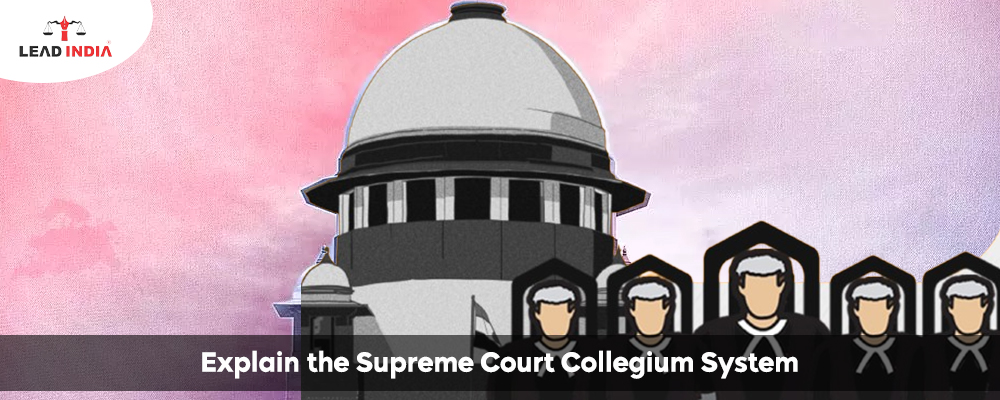The Supreme Court’s Collegium System is led by the Chief Justice of India and includes four other senior justices. The current Chief Justice and two other senior judges lead a High Court collegium on the court. Higher-level judges are recruited solely through the collegium system, with the government having no participation after the collegium has settled on candidates.
What is the Collegium System, and how did it evolve?
The mechanism of appointing and transferring judges is based on Supreme Court decisions rather than legislative acts or Constitutional provisions.
Need A Legal Advice
The internet is not a lawyer and neither are you. Talk to a real lawyer about your legal issue

Evolution of the Collegium System
- The First Judges’ Case (1981) clarified that the CJI’s proposal on judicial appointments and transfers could be denied for “cogent reasons.” The verdict gave the Executive Branch precedence over the Judiciary in judicial nominations for the next 12 years.
- Second Judge’s Case, 1993: The Supreme Court Advocates on Record Association (SCARA) submitted another petition in 1993. In this instance, the Supreme Court reversed its earlier decision and redefined consultation as concurrence. Thus, the President of India is bound by the Chief Justice of India’s discussions. This led to the establishment of the Collegium System.
- Third Judges Case, 1998: In 1998, the president referred to the Supreme Court, challenging the definition of the word consultation in articles 124, 217 and 222 of the Constitution. The chief justice will be one of many people involved in the consultation process. A collegium of four senior Supreme Court judges would participate in the consultation. Even if two of the judges disagree with the opinion, the CJI will not propose it to the government.
Procedures for Judicial Appointments?
- For Chief Justice of India: The President of India appoints the Chief Justice of India and the other judges of the Supreme Court. The outgoing Chief Justice of India proposes his replacement. Since the 1970s supersession debate, seniority has been severely enforced.
- For the Supreme Court judges: The Chief Justice of India initiates the idea for the other Supreme Court judges. The CJI discusses with the remaining Collegium members as well as the senior-most judge of the court from the High Court to which the recommended individual belongs. Consultees must write down their opinions, which should be kept on file. The Collegium forwards the advice to the Law Minister, who then sends it to the Prime Minister, who advises the President.
- For the Chief Justice of High Courts: The Chief Justice of the High Court is appointed by the policy of having Chief Justices from outside of their respective states. The Collegium decides on the elevation. A Collegium of two senior judges and the Chief Justice of India recommends High Court judges. However, the outgoing Chief Justice of the High Court in conjunction suggested with two senior colleagues. The recommendation is conveyed to the Chief Minister, who urges the Governor to forward the request to the Union Law Minister.
Why did the National Judicial Appointments Commission Act come into effect?
The Collegium System was heavily criticized not just by the administration but also by civil society for its lack of transparency and accountability. This resulted in the 99th Constitutional Amendment Act (NJAC) of 2014, which replaced the collegium system for appointing judges.
In October 2015, a five-judge Constitution Bench deemed the National Judicial Appointments Commission Act (NJAC) and the Constitutional (Ninety-Nine Amendment) Act, of 2014 invalid based on the 1993 judgment. NJAC would also recommend names for the appointment and transfer of High Court Judges.
Way Forward
Filling vacancies is an ongoing and collaborative process that involves both the executive and the judiciary, and there is no timetable for it. However, it is time to consider establishing a permanent, independent body to institutionalize the process with necessary protections to protect the judiciary’s independence, ensuring judicial primacy but not judicial exclusivity. It should ensure independence, exhibit diversity, and show professional skill and integrity.
Lead India offers various legal services, such as free legal advice and internet information. We provide a facility in which you can talk to a lawyer and ask legal questions regarding the law here. Lead India’s lawyers can assist you with any legal issues. In India, Lead India provides free legal assistance online. In addition to receiving free legal advice online, Lead India allows users to pose inquiries to experts for free.





 Talk to a Lawyer
Talk to a Lawyer